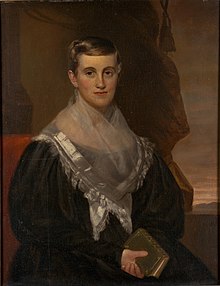
Back برودنس كراندال Arabic برودنس كراندال ARZ Prudence Crandall Catalan Prudence Crandall German Prudence Crandall Spanish Prudence Crandall Basque Prudence Crandall French プルーデンス・クランドル Japanese Prudence Crandall Portuguese Крэндалл, Пруденс Russian
Prudence Crandall | |
|---|---|
 Crandall, 1834 portrait by Francis Alexander | |
| Born | September 3, 1803 |
| Died | January 28, 1890 (aged 86) |
| Occupation | Teacher |
| Years active | 1830s |
| Known for | Canterbury Female Boarding School |
| Spouse | Calvin Philleo |
| Awards | State heroine of Connecticut |
| Academic background | |
| Education | Black Hill Quaker School |
| Alma mater | Moses Brown School |
| Academic work | |
| Institutions | Canterbury Female Boarding School |
| Notable ideas | Black girls had the same right to education as white girls. |
| Signature | |
Prudence Crandall (September 3, 1803 – January 27, 1890) was an American schoolteacher and activist. She ran the Canterbury Female Boarding School in Canterbury, Connecticut,[1] which became the first school for black girls ("young Ladies and little Misses of color") in the United States.
In 1832, when Crandall admitted Sarah Harris, a 20-year-old African-American woman, to her school,[2][3] she created what is considered the first integrated classroom in the United States.[4] Parents of the white children began to withdraw them.[2] Prudence was a "very obstinate girl", according to her brother Reuben.[5] Rather than ask the African-American student to leave, she decided that if white girls would not attend with the black students, she would educate black girls. She was arrested and spent a night in jail. Repeated trials for violating a Connecticut law passed to make her work illegal, as well as violence from the townspeople, resulted in Crandall being unable to keep the school open safely.[6] She left Connecticut and never lived there again.[2]
Much later the Connecticut legislature, with lobbying from Mark Twain, a resident of Hartford, passed a resolution honoring Crandall and providing her with a pension. Twain offered to buy her former Canterbury home for her retirement, but she declined.[7] She died a few years later, in 1890.[4]
In 1995 the Connecticut General Assembly named her the State Heroine of Connecticut.
- ^ Green, Arnold W. (January–March 1966). "Nineteenth Century Canterbury Tale". Phylon. 7 (1): 58–63. doi:10.2307/271285. JSTOR 271285.
- ^ a b c Wormley, G. Smith. The Journal of Negro History, "Prudence Crandall", Vol. 8, No. 1, January 1923, pp. 72–80. JSTOR 2713460
- ^ Tisler, C.C. "Prudence Crandall, Abolitionist", Journal of the Illinois State Historical Society (1908–1984), Vol. 33, No. 2, June 1940, pp. 203–206. JSTOR 40187935
- ^ a b Cite error: The named reference
Smallwas invoked but never defined (see the help page). - ^ The trial of Reuben Crandall, M.D. : charged with publishing seditious libels, by circulating the publications of the American Anti-Slavery Society, before the Circuit Court for the District of Columbia, held at Washington, in April, 1836, occupying the court the period of ten days. New York: H. R. Piercy. 1836. p. 35. Archived from the original on September 2, 2020. Retrieved March 10, 2020.
- ^ "State Heroine Prudence Crandall". ConnecticutHistory.org. September 3, 2020. Archived from the original on November 29, 2023. Retrieved April 2, 2024.
- ^ "Prudence Crandall and the Canterbury Female Boarding School". Country Cultures. May 15, 2011. Archived from the original on July 20, 2019. Retrieved July 15, 2019.
© MMXXIII Rich X Search. We shall prevail. All rights reserved. Rich X Search